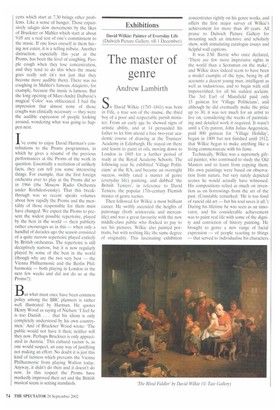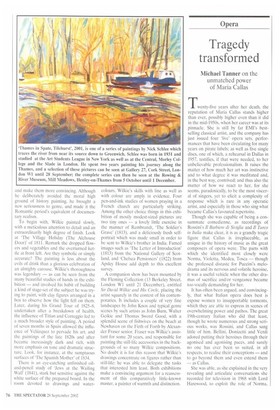The master of genre
Andrew Lambirth
Sir David Wilkie (1785-1841) was born in Fife, a true son of the manse, the third boy of a poor and respectable parish minister. From an early age he showed signs of artistic ability, and at 14 persuaded his father to let him attend a free two-year academic course of drawing at the Trustees' Academy in Edinburgh. He stayed on there and learnt to paint in oils, moving down to London in 1805 for a further period of study at the Royal Academy Schools. The following year he exhibited 'Village Politicians' at the RA, and became an overnight success, swiftly rated a master of genre (everyday life) painting, and dubbed 'the British Teniers', in reference to David Teniers, the popular 17th-century Flemish master of genre scenes.
Then followed for Wilkie a most brilliant career. He swiftly ascended the heights of patronage (both aristocratic and mercantile) and was a great favourite with the new middle-class public who flocked to pay to see his pictures. Wilkie also painted portraits, but with nothing like the same degree of originality. This fascinating exhibition concentrates rightly on his genre works, and offers the first major survey of Wilkie's achievement for more than 40 years. All praise to Dulwich Picture Gallery for mounting such an intensive and scholarly show, with stimulating catalogue essays and helpful wall captions.
It was J.M. Barrie who once declared, 'There are few more impressive sights in the world than a Scotsman on the make', and Wilkie does indeed seem to have been a model example of the type, being by all accounts a decent young man, intelligent as well as industrious, and to begin with still impoverished, for all his sudden acclaim. The 3rd Earl of Mansfield paid only 15 guineas for 'Village Politicians', and although he did eventually make the price up to 30, it was not much for an artist to live on, considering the weeks of painstaking and detailed work it required. It wasn't until a City patron, John Julius Angerstein, paid 800 guineas for 'Village Holiday', begun in 1809 but not finished until 1812, that Wilkie began to make anything like a living commensurate with his fame.
Technically, Wilkie was a supremely gifted painter, who continued to study the Old Masters and to learn from copying them. His own paintings were based on observation from nature, but very rarely depicted scenes he would actually have witnessed. His compositions relied as much on invention as on borrowings from the art of the past. (Constable remarked: 'He is too fond of rancid old art — but his soul saves it all.') During his lifetime he was seen as an innovator, and his considerable achievement was to paint real life with some of the dignity and conviction of history painting. He brought to genre a new range of facial expression — of people reacting to things — that served to individualise his characters and make them more convincing. Although he deliberately avoided the moral high ground of history painting, he brought a new seriousness to genre, and made it the Romantic period's equivalent of documentary realism.
To begin with, Wilkie painted slowly, with a meticulous attention to detail and an extraordinarily high degree of finish. Look at 'The Village Holiday (The Alehouse Door)' of 1811. Remark the dropped flowers and vegetables and the overturned kettle at front left. Are they symbolic or simply accurate? The painting is less about the evils of drink than a glorious celebration of an almighty carouse. Wilkie's thoroughness was legendary — as can be seen from the many beautiful studies of hands in the exhibition — and involved his habit of building a kind of stage-set of the subject he was trying to paint, with clay figures arranged in a box to observe how the light fell on them. Later, during his Grand Tour of 1825-8, undertaken after a breakdown of health, the influence of Titian and Correggio led to a much broader style of painting. A period of seven months in Spain allowed the influence of Velazquez to pervade his art, and the paintings of the late 1820s and after became increasingly dark and rich, with more emphasis on tone and dramatic structure. Look, for instance, at the sumptuous surfaces of 'The Spanish Mother' of 1834.
There is an eye-catching unfinished oiland-pencil study of 'Jews at the Wailing Wall' (1841), stark but sensitive against the white surface of the prepared board. In the room devoted to drawings and water colours, Wilkie's skills with line as well as with colour are amply in evidence. Four pen-and-ink studies of women praying in a French church are particularly striking. Among the other choice things in this exhibition of mostly modest-sized pictures are two tiny ones — a lovely little exercise in the manner of Rembrandt, 'The Soldier's Grave' (1813), and a deliciously fresh selfportrait which was made small in order to be sent to Wilkie's brother in India. Famed images such as 'The Letter of Introduction' (1813) from the National Gallery of Scotland, and 'Chelsea Pensioners' (1822) from Apsley House add depth to this excellent survey.
A companion show has been mounted by the Fleming Collection (13 Berkeley Street, London W1 until 21 December), entitled Sir David Wilkie and His Circle, placing the artist squarely in the context of his contemporaries. It includes a couple of very fine landscapes by John Knox and typical genre scenes by such artists as John Burn, Walter Geikie and Thomas Sword Good, with a splendid scene of fishwives on the beach at Newhaven on the Firth of Forth by Alexander Fraser senior. Fraser was Wilkie's assistant for some 20 years, and responsible for painting the still-life accessories in the backgrounds of so many Wilkie compositions. No doubt it is for this reason that Wilkie's drawings concentrate on figures rather than still-life: he was able to delegate the tasks that interested him least. Both exhibitions make a convincing argument for a reassessment of this comparatively little-known master, a painter of warmth and distinction.



































































































 Previous page
Previous page